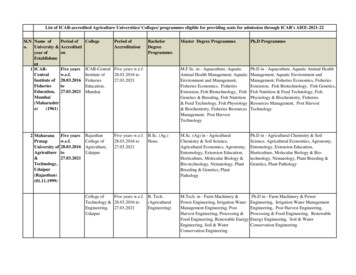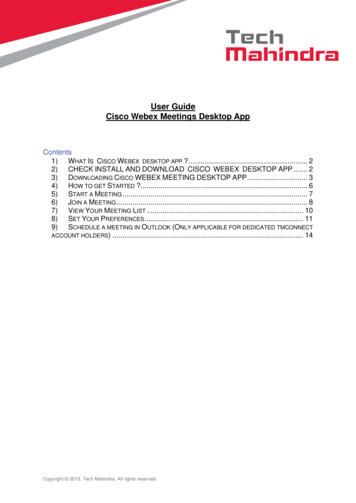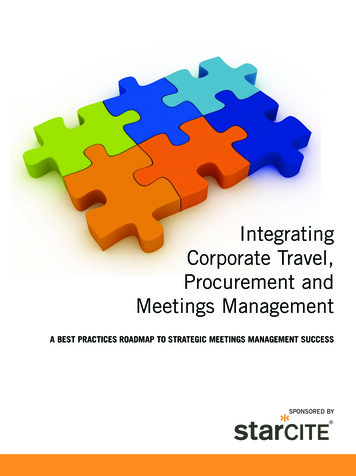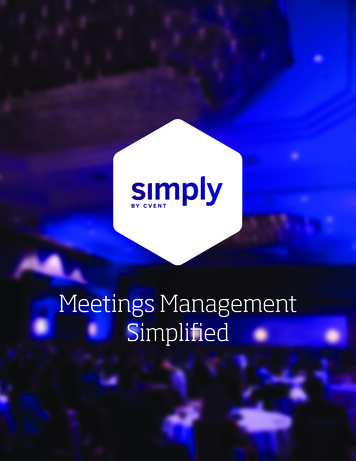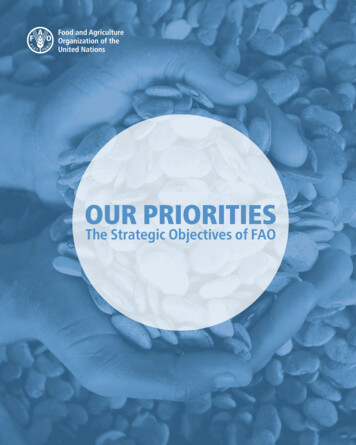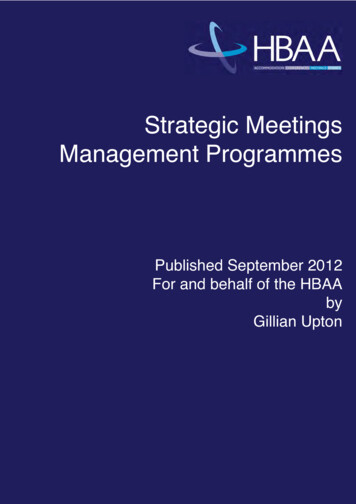
Transcription
Strategic MeetingsManagement ProgrammesPublished September 2012For and behalf of the HBAAbyGillian Upton
CONTENTSIntroduction3Objectives of an SMMP5The key RFP players4Alternatives6Cost implications8Reality Check9The challenges10Winners and losers12Case Study 1: IBM14Case Study 2: Linklaters16Learnings/outcomes/ best practice17Summary/The future18About the HBAA20Acknowledgements20About the author20
INTRODUCTIONThe growth of strategic meetings management programmes (SMMPs) over the last five years has been slow in theUK and been driven by larger-sized corporates with larger volumes of low touch events and more opportunity toaccrue benefits.The subject is certainly on the radar of most corporates but for many the talk does not translate into action. Strategicmeetings management is seen as the last bastion of unmanaged travel, particularly if the corporate has alreadyglobalised transient spend. Corporates know that strategically managing M&E spend will help leverage suppliersand mitigate risk, something that is a crucial component of any SMMP.The trend has been driven by the relatively new introduction of procurement professionals into the buying andmanagement of Event Services. They firmly believe that strategic sourcing can bring cost savings, reduce spend andgenerate a full set of data.The Chartered Institute of Purchasing & Supply (CIPS) reckons strategic sourcing can save anywhere between 1029%, placing travel and incentives as a key category for procurement to manage. There are many statistics thatreinforce the size of opportunity that SMMPs deliver but perhaps one – that some 40% of corporations cannot identifyhow much is spent on meetings – speaks volumes.An integral part of the SMMP is the implementation of technology. No-one doubts that technology is an enabler, butunlike the US market, few companies in the UK have automated all elements of their events programme. Thisperfectly points up the stark difference between the two markets, namely that the US is more process driven and theUK more high touch.Corporates starting out on this journey are choosing to automate the labour intensive elements of meetingsmanagement, namely delegate registration and, to a lesser degree, the RFP process/venue find.The low adoption of RFP tools has been likened to the introduction of self booking tools (SBTs) into the transient sideof the business ten years ago, when the efficacy of US imported tools was questioned and post sales support waslacking.SBTs have been accepted for use for only point-to-point, simple journeys by air and industry observers believe eRFPswill only work for small simple meetings of say, 20 people wanting one meeting room.The agency community has not welcomed their introduction and will work with the tools only when clients dictate.Concerns over double entry, clunky interfaces with their own system, cost and more fundamentally, underminingtheir business models, are at the heart of agency concerns.Several homegrown eRFP solutions have been spawned, as well as hybrids from the specialist agencies that providemeetings management services such as venue find.One market characteristic unites all markets, and that is the fragmented nature of the spend within an organisation,where multiple personnel all book meetings independently. It requires special attention to all stakeholders if anychange management programme is to be successful.3
OBJECTIVES OF AN SMMPThe objectives of a strategic meetings managementprogramme are to first and foremost gain visibility of themeetings spend. Until companies have a handle onexact expenditure, a company has no idea what thesavings opportunities are.Continuity of reporting tool is another plus of using anexternal reporting tool, should the corporate switchagencies.Typically today, one in seven companies in the UK donot have a policy in place for their transient spend so onehas to assume that the equivalent statistic for SMMPs,which have only been around for the last five years, willbe even less.HBAA member Grass Roots cites an example of a clientcompany booking 26 different venues for internal trainingevents. They consolidated to one venue and saved 1mpa.Cvent's Lisa English, Marketing Manager for StrategicMeetings Management, lists four main objectives for anSMMP:Finding total meetings expenditure is complicated by thefact that the spend is usually fragmented across anorganisation and booked by multiple departments, suchas HR, Marketing, PAs and secretaries, and not usuallymanaged by one person. These departments often donot talk to each other and therefore the information is notcentrally collected. There can often be a community ofup to 20 people responsible for booking meetings.1.2.3.4.It is no surprise that companies are usually way off inguesstimating M&E spend. So often a 3-4m estimatedbudget turns out to be 10m when items such as AVevent costs are included. Very often HR and Training willaccount for around 50% of annual spend.The characteristic of a highly fragmented spend iscoupled with seldom any process or policy, no commonstandards policy, poorly tracked spend with diversebudget owners, lack of events experience andknowledge internally and a sense of ʻownershipʼ by thebookers. In short, it is very different from transientbusiness travel.It's no wonder that procurement likes technology-drivenSMMPs. They make the spend reportable and expenseable.Other objectives of an SMMP are process automation,improved sourcing and procurement - usually byconsolidating the supply chain – improved complianceand risk mitigation. See table below. The table shows thelargest potential savings from sourcing and procurementat 4.8%- 8% but Iona Courtenay-Warren, Head ofMeetings & Events at Hotelscene, reckons thatʼsconservative and that big savings come in Year 2 of aSMMP and range between 19-22% typically, fromconsolidation of the number of suppliers.visibility as to what meetings are taking placerisk mitigationsavings and leveraging spendprocess .Process Automation3%-6.5%CostSourcing & Procurement4.8% - 8%CostVisibility & Control2.4% - 5.5%CostCompliance & Risk1.6% - 5%CostMeetings Effectiveness0.5% - 5%Revenue & BenefitTOTAL12.3% - 30%"It's savings off fixed costs, not variable costs, that clientsare after, " says Grass Roots' David Taylor, referring toitems such as headcount.One law firm managed to lose two staff from its internalevents team once it had automated the delegateregistration process, for example.In terms of process automation, BDRC reckons it takeson average 11 minutes to make a phone booking,whereas it could be done in three clicks on an eRFP tool.Traveller safety is the big issue today so being able torun a report to find out where the event is, the contactdetails of the organiser, a list of delegates and so on isessential.4
THE KEY RFP PLAYERSThe major RFP players are two US software solutionproviders, StarCite and Cvent.Europe. This may be a disadvantage to SMEs."With Cvent, there's very little content in the provinces,"highlights Conference Care's Andrew Deakin. "ABC hasbetter content than Cvent."Both providers have made inroads in the US with largemultinationals, with a similar user pattern in the UK withthe likes of Shell, Pfizer and Deutsche Bank (StarCite)and P&G (Cvent) as early adopters.StarCite's Iwamoto says: "Boutique hotels or unusualvenues traditionally don't participate as they donʼt havethe resource to participate."Cvent is a sophisticated online event management toolsuitable for multi-day events that includes eventregistration functionality and seamless integration with acompany website. It also offers multi-languagetranslation and transaction in multi currencies. It carriesa substantial set-up fee.Another criticism is the 'clunky interface'. "Cvent andStarCite are incredibly difficult to navigate through andunderstand what they're asking for. It can take a longtime and you're basically making their whole proposal forthem", says Sharon Joseph of The Belfry Hotel.StarCite grew from a registration technology companyfor the sporting events and its main objective is processefficiency and visibility of conference spend. Earlyadopters were pharma and financial companies as theyare required to report their spend and attendees by law.The company entered the UK market eight years ago.Some agencies feel they are having to pick up the piecesfor the shortcomings of the systems. Said one agent,who preferred to remain anonymous: “Some corporatespay for a system and theyʼre damn sure theyʼre going tomake it work. You canʼt be seen to be negative. Itʼs thrustupon us but there is very little benefit.”Industry observers say StarCite is more suitable for thelarger conventions of 150 delegates and above althoughthe company says its system is modular and scalableand satisfies any size of scale of event and/or corporate.One praiseworthy comment came from BSIs Quintrell,who said Cvent is "very active in terms of forums andengaging their customer base."The tools do a number of things well, particularly for acorporate that doesn't engage an agent. If they push allmeetings through the tool, corporates can capture MIthey wouldn't otherwise get, excellent reporting andmanagement of soft approval.The perception of some buyers is that StarCite andCvent are too big to take on, "yet they can switch off thebits they don't need" explains Hotelscene's CourtenayWarren.StarCite has recently added iPhone and iPad capabilityand a Meetings Locator, which allows meeting plannersto ballpark price by destination.Both providers have approached the UK marketdifferently to their home market. Explains Cvent'sEnglish: "The personal relationships in the Europeanmarketplace are so different to the US, so we've taken asofter approach, a phased approach and it's changedour expectation.”Content of both software providers is one thorny issueas they focus on the major hotel chains and offer lesscoverage of independent hotels and the more unusualvenues more prevalent across the UK and continental5
ALTERNATIVESThere are two main homespun alternatives to the big USplayers, ABC Connections and Venue Directory.The strategic RFP is following its transient counterpartwith annual agreement for day delegate rates and 24hour delegate rates being contracted with venues thathave appropriate facilities.ABC Connection has provided its Request for Meetingssolution exclusively to agents over the last decade. “ABCdoesnʼt deal with corporates directly because that wouldmake us an agent. Our role is to support large, mediumand smaller agents in dealing with major corporateaccounts as well as providing a solution for dealing withSMEʼs requirements cost effectively” says ABC chairmanMartin Coleman.Agents are starting to drive tactical RFPs via bespokeclient-facing portals which aids compliance and providesa very cost-effective solution to both the agent and itscorporate clients” concludes Coleman."A number of the HBAA community have been takingcontent from them for a number of years so there is afamiliarity and trust there," said BSIs Jim Quintrell.ABC provides agents with a global enterprise solutionwith the scope and flexibility to be tailored to match theagency processes and specific needs of their clients.“Our portals allows agents to wrap the technologyaround their own business processes instead of havingto change those processes to suit, thereby making thoseprocesses more efficient” says Coleman."Venue Directory and ABC Connections are simpler toolsand more generic," says The Belfry's Sharon Joseph.Venue Directory is a web-based online RFP tool with acomprehensive database of meetings venues, many ofwhich include virtual show rounds now available onsmart phones, but 60% is UK based. Itʼs a tool for agentsand the venues are charged for this 'free service'. Thetool that will generate a proposal and venues like it as ithas one of the simplest RFPs to complete. The companysends out an automatic reminder to venues to respondafter one hour, and a phone call after two hours in a bidto drive the RFP forward.However, ABCʼs Martin Coleman believes that agentshave recognised that speed is not the sole criteria for anRFP tool to be truly effective for their clients.“RFPʼs are not just about speed. The Request forMeetings process has become more complex becausecompaniesʼ duty of care responsibilities towards theiremployees is now uppermost in their venue selectioncriteria. It is the quality of both the general venue andspecific Health & Safety and disabled traveller relatedinformation available through RFP tools that reallycounts. And because most hotels have warehoused thisinformation with ABC, we are able to combine quality ofdata with the speed of response that agents nowdemand” says Coleman.It has 20,000 registered users. Venue Directory is bestutilised by smaller corporates without an agent.The company claims it takes between two and 15minutes to fill in the request form online, answeringquestions that are bespoke to the client that will be sentto some 27,000 meetings and events venues by namesof individuals.“Any RFP is a two-way negotiation” says ABCʼs MartinColeman. “Our tool makes the process much easier witha built-in negotiation process as well as an instantmessenger solution; the entire process takes placeonline ensuring that the agent receives highlycompetitive rates for their clients.”“Five years ago getting hotels to fill in RFP forms was areal struggle,” says Venue Directoryʼs MD MichaelBegley. “In 2008 the average was three hours, in 2012itʼs under two and hoteliers like De Vere Venues areexcellent, at 30 minutes on average.“We are now seeing a step-change in the meetings RFPprocess” says ABCʼs Martin Coleman. “Effectively theprocess is falling into two distinct functionalities:1.2."Rather than pick up the phone to 12 venues, agents canspend ten minutes filling in the RFP and send it to 12venues then wait for the responses to come in," saysBegley.Strategic: annual negotiation for contractedmeeting ratesTactical: Request for Meetings for individualevents"These systems [StarCite and Cvent] inherently makethe process impersonal. StarCite and Cvent are globaland more impersonal whereas Venue Directory is a littlemore personal as it's domestic although maintaining thatwill be difficult as they grow, says The Belfry's Ian Cross.6
Other solutions include Gratis, Meeting Broker, etouches, Event Check-In and Demo Media.Excel spreadsheets, phone calls and emails - the originalmanual process - is still in widespread use. Detractorssay data is not easily transferable and lacking inhistorical data, but this system often works well for asmall meetings programme.The big push has been for agents to develop their ownsystems in-house, such as Arcania Metron, ZAPP andMy Stay, that is if they havenʼt jumped on the bandwagonwith StarCite or Cvent. Some in-house systems areform-based portals that require manual intervention oncean enquiry is received.Hotelscene developed My Stay as a transient selfbooking tool. It takes the feed from the GDS andHotelscene's own database. It's a form that sits on aclient portal and can incorporate an authorisationprocess. The form is emailed back to the agency, is thenautoloaded into Hotelscene's booking system and is thenworked on. Venues have to respond within 24 hours aspart of the agency's standard SLA.Zibrantʼs Chris Parnham warns, ”We either come out andattack RFP tools or jump on board and work with themand implement them with our tools. Weʼve invested toprotect our market share from these global RFPproviders. Youʼve got to challenge the technology threat.”Ultimately, there will be an end-to-end solution forbookings that will go from the enquiry submitted, to therate, availability, booking, and a confirmation back to thecustomer. "That's the holy grail," says BSIs Quintrell.BSI is planning to launch an end-to-end system this year.7
THE COST IMPLICATIONSThe RFP tool providers operate a number of differentcost models based on their clients' needs. The mostcommon model is that the corporate client purchasestheir own licence for the technology for their use.says, "it's a smart system that links into Delphi viaMeeting Broker. Delphi is the booking tool that 80% ofthe UKs meeting room inventory is managed on." Theyhave recently dropped another tool because theycouldn't demonstrate ROI.Agencies also purchase a licence to use on behalf oftheir clients. Hotels do not pay to be listed but the stingcomes if they wish to purchase upgraded listings todisplay more content on their profile page.Agencies also incur a cost when dealing with the numberof booking amendments and the number of times theyhave to touch a booking.Neither of the main RFP tool providers – ie StarCite andCvent – was prepared to divulge start-up costs."The requirement is a budget and a headcount,” saysKevin Iwamoto, GLP Vice President Enterprise Strategyat StarCite. "A budget, that's the major challenge. If thecompany is only using the registration module then that'sa low entry point; if its the approval process, websitefunctionality it's another charge so the pricing varies."The model is an annual licence fee based on number ofusers, plus ongoing transaction costs which depend onthe volumes the corporate can push through. "Thetransaction fee is volume led and it's offset by thesavings you make," explains buyer Richard Eades.Cvent stresses that its software is a modular system andcustomers need only pay for the modules they want. Inaddition, customers can download for free Cventʼs RFPtool.Zibrantʼs Parnham refers to the cost being “Hundreds ofthousands of pounds of investment. Itʼs a six-figure sumif a buyer is covering a multi centre territory, plus thetransaction fees.”Venue Directory charges the venue an annual flat feeand it is marketed to corporates as a free service. Thatannual fee is reportedly a five-figure sum.One anonymous agent put the cost in perspective: “Ifhotels want 3D images, promotional offers and somereporting thereʼs an annual fee of 700. Think ofPrincipal Hayley with 28 hotels and that's 20,000pa, justfor one hotel group. At 20,000 a pop thereʼs only somany tools you can afford to work with.”De Vere Venues, for example, pays Venue Directory anannual fee per property but the company's Ian Jones8
A REALITY CHECKThe reality is somewhat different to the optimum waySMMPs and eRFP tools can be employed, in many cases.from experience when he says: "eRFP tools are afacilitator, not a solution. Remember that you're buyingan application off the shelf and it won't work exactly asyou want it to work.”StarCite's Iwamoto sums it up when he says: "It's notabout the technology, it's mostly about changemanagement.""Which tool to use will depend on the scope and scale ofyour business; the home-grown tools are only for the UK."He cautions that nobody uses any new technology to its fullpotential of 100%; "it's more like 50-60% but that's humanbehaviour. People have got to change their mindset."And there's the rub. Hotelscene's Iona-CourtenayWarren points to a "disconnect between procurementwho want to control meetings spend and the meetingsbookers who don't want to do anything to upset theirchoices of hotels they make."Serco dipped a toe in the water with an SMMPexclusively for any meeting worth over 1,000 bookedthrough Venue Directory. Bookings under 1,000 couldbe booked direct but data uncovered that these leastcostly meetings accounted for 25% of spend so theyhave now been incorporated into the SMMP.The table below neatly encapsulates all the pieces of thepuzzle that have to be in place in order to make theentire SMMP work.Process-driven IBM has taken on all components of theRFP tool (see case study on page 14) but Deloittes, withits high-touch events portfolio, has eschewed technologyand relies on Excel spreadsheets. Turn to page 16 for acase study on Linklaters, a company with a similarevents profile.One wonders, however, aboutproductivity issues when the spreadsheets need to becollated or a report is required at short notice.However, the likes of Deloitte and Linklaters are notalone as many corporates manage event registration onspreadsheets and printed lists.Other corporates mix and match, by requesting the firsttranche of information online, then switch to picking upthe phone to the venues that have shown availability.For the agency community, however, the SMMP posesother problems. “If youʼre the PA to the Chairman of ICIand organising the companyʼs AGM, do you leave it tointerpretation by computer or start to build up arelationship with a person? You canʼt negotiate with acomputer,” says Guy Mason of Brief to Event.The Belfry says that only 4-5% of its enquiries come viaonline. "Clients may go online to look, but then they pickup the phone," says The Belfry's Joseph. "Sixty per centof our business comes in via emails but they all ask fora call back to talk it over."So what are corporates getting that a traditional agentcan't deliver? Martin Coleman, Chairman of ABCConnections, sums it up in five points:*A technology-based solution that reducesinternal processing costs*An efficient tool that reduces internal time andcost*A tool with which to monitor and benchmarkagency KPIs*Greater consistency of response time, qualityand depth*Ability to incorporate payment processes“For an annual event with a budget of 200,000, contactwith the venue supplier is essential,” he says. “For largerevents itʼs too important not to get the relationship right.My business is about providing lots of cotton wool; wemake that PA the most important person in the world, butif youʼre a a big TMC and booking a room for ten itʼsabout numbers and driving efficiencies.”Buyer Richard Eades, past chairman of the HBAA andnow a global procurement manager in the oil and gasindustry, is six months into a global SMMP so speaks9
THE CHALLENGESOne events professional with over 20 yearsʼ experiencedoesnʼt “see enough value in what [RFP tools] offer. Itʼsa tool so it still needs people to use it in the right way.They can work well but the industry doesnʼt seem to beaccepting this change as only 1% of business is comingthrough those channels. It doesnʼt seem to be gaininglegs.” Picking up the phone is his preferred method.eliminate human contact and while itʼs good for thebusiness model of the TMCʼs, itʼs not for us as a smalleragency,” believes Mason.He believes RFP tools have a role with high volume, lowspend “churn business that is low touch. Your cookiecutter events of say, 20 people and a 2,000 spend, andthen you can interface with a computer. Computers dothings in a two-dimensional way but as soon as you need3D then people work best.”Chris Parnham of Zibrant doesnʼt “rate RFP tools at all”.He says: “You canʼt take the personal aspect out of theprocess at all. Meetings are about the experience as wellas the price and you get a much better solution if you geta person contacting the venue. Venues value a personalcontact. Result in. Result out.”This buyer says that as soon as there is a large spendand complexity of meeting then there is no substitute foran events professional who can really add value.“Theyʼll know that thereʼs no daylight in the room, thatthereʼs no space adjacent for the coffee breaks, enoughspace for a back projector or registration desk; an expertwill ask these questions. A computer can convey thatinformation in a report but Iʼm not convinced the data isreally robust.”However, he highlights a conflict between venues andagents and what buyers want and believes there needsto be “a halfway house solution” to harness those twotogether.He is also not convinced that, currently, the RFP toolsout there are as cutting edge as they should be. “Thething that puts people off is how complicated they are butthat will improve as the interface becomes moreseamless. None of them are there yet, theyʼre still a bitclunky."Larger agencies realise that yields and transactionalvalues are quite low on their low-touch repeat businessand that there are efficiencies to be made by utilisingtechnology here.Smaller agencies such as Brief to Event are concernedabout losing the close relationship they have with theend user and about losing the quality of service.He believes that 30% of global spend – the longschedule training, local meetings and so on - could becommodotised and booked via an RFP tool. “But thelikes of annual retreats is something else,” he warns.The other challenges are that an eRFP tool encouragesmore shopping and, as a result, venues are not enjoyinghigh conversion rates. "The majority of opportunitycomes as a result of our sales or marketing activity," saysDe Vere Venuesʼ Ian Jones.The industry is hoping for consolidation and a few goodtools that work, in the long term.If the technology isn't there yet, then nor is the after salesservice. Mark Jelley, Deputy Chair of HOSPA, theassociation for hospitality finance, revenue and ITprofessionals, believes "software providers generallydon't educate".Nicola Chapman, Director of Sales for Agents at HiltonWorldwide, agrees. "Conversion is small so theopportunity has to get re-qualified," she says. "The RFPinfo is incredibly vague so you have to pick up the phonea lot of the time and ask questions like, 'Are the datesfixed?' "The smaller agencies have eschewed technology for themost part while the larger agencies have soughtefficiencies of scale by automating the labour-intensiveparts of their business so staff can concentrate on whiteglove service. That may mean buying proprietarytechnology solutions or developing systems in-house.Jim Quintrell of BSI concurs: "RFP tools, in the wronghands, can lead to unqualified requests that don'tconvert into confirmed business. If the phone is ringingand it's an agent and the inbox is flashing and it'sStarCite, which do you respond to? There still seems tobe a lower priority placed on responding to an eRFPrequest."SMMPs and eRFP tools pose a real threat to smalleragencies. Says Guy Mason of Brief to Event: “Thedanger is that as a smaller company we do ourselvesout of the market.” Meetings are seen to beingcommodotised by the likes of StarCite and Cvent. “TheyHilton's Chapman agrees that the highest return comesfrom a call or email or direct booker.10
RFP tool but it has no foundation, he says. "Weencourage venues to update website prices and anyarguments over price differentials disappear as it's all inwriting, whereas with a telephone call it's, 'He said thisprice." 'Ian Leat, Director GSA Network Europe & GSO Spain atMarriott Hotels International Ltd, also agrees. He says:"It's so easy to click a button so for one enquiry a bookercan look at 50 hotels so there is a potential of lowconversion for us. Also duplication of effort sometimesso we always look to place the enquiry to the mostrelevant location, as we don't want to flood the hotel withthe same enquiry. It's also labour intensive to answer theRFPs."There appears to be no issue over data ownership. TheRFP tool providers may be the custodians but thecorporate unequivocally owns the data.The plea from hotels is for the RFP tools to be usedproperly and to run webinars and seminars for bookersin order to achieve that next step.Buyer Richard Eades disputes the low conversion rateclaim. "Over 90% of enquiries we put into our tool end upbeing a converted piece of business. We need aminimum of three bids so the venue is already on a 33%opportunity."StarCite's Iwamoto explains that the shopping behaviourreflects novelty with the tool and it changes with time."As bookers mature and adapt they behave morerationally and only send bids to three or six venues ratherthan 12," he says.Venues are also concerned about the length of timeclients request that venues hold the space. "There maybe 12 venues all holding space, with no qualification asto why," says The Belfry's Joseph. Had the venue directlyinputted the request they would have asked thequestions, 'What matters to your event?', 'What othervenues are you holding?', 'Are they city centre?', etc etcfrom which the venue can decide whether to put it onhold or not. "Add The Belfry's Cross: "This is when the feel and theexperience of event booking comes into play."The automated RFP "breaks the relationship betweenthe venue and the agency, adds Joseph.Another challenge is implementation and post saleswhere all technology providers "fall down" says buyerRichard Eades. "Webex is their solution to everythingrather than adapting and changing the product. They sellthe product but fail to take the consultative position. Theywait for the customer to find out what they actually need."Venue Directory's Begley raises the issue thatcorporates don't believe they'll get the best rate on an11
WINNERS AND LOSERSThe winnersThe winners are clearly the corporate buyers. They areable to achieve visibility of spend, improve MI, leveragespend with suppliers and save money and mitigate riskin terms of standardised contracts and delegate trackingand, if they implement the programme correctly, bettercompliance. Itʼs a win-win for them.The RFP tools can be beneficial if venues pay to engagewith the promotional packages to enhance their listingbut this is overshadowed by the hidden cost of the timeit takes to fill in the RFP and convert to bookings.Hotels and venue suppliers also have to make toughdecisions as to which sales channel/s to pay for, as theycan't afford all of them. "They are a massive cost tohoteliers," says De Vere Venuesʼ Ian Jones. The hotelgroup recently handed its notice in to one major supplier asthey were unable to show any ROI on the 25,000pa cost.Moreover, by using an external tool, buyers achievecontinuity of systems if they choose to change agencies.They can shop around more, undertake 20 proposals in 24hours if they so wish, and are able to compare apples withapples as every venue will have received the same spec.Ultimately venues will have to swallow these notinsignificant costs that being part of these systems incursand it is fair to speculate t
The objectives of a strategic meetings management programme are to first and foremost gain visibility of the meetings spend. Until companies have a handle on exact expenditure, a company has no idea what the savings opportunities are. HBAA member Grass Roots cites an example of a client company booking 26 different venues for internal training .

